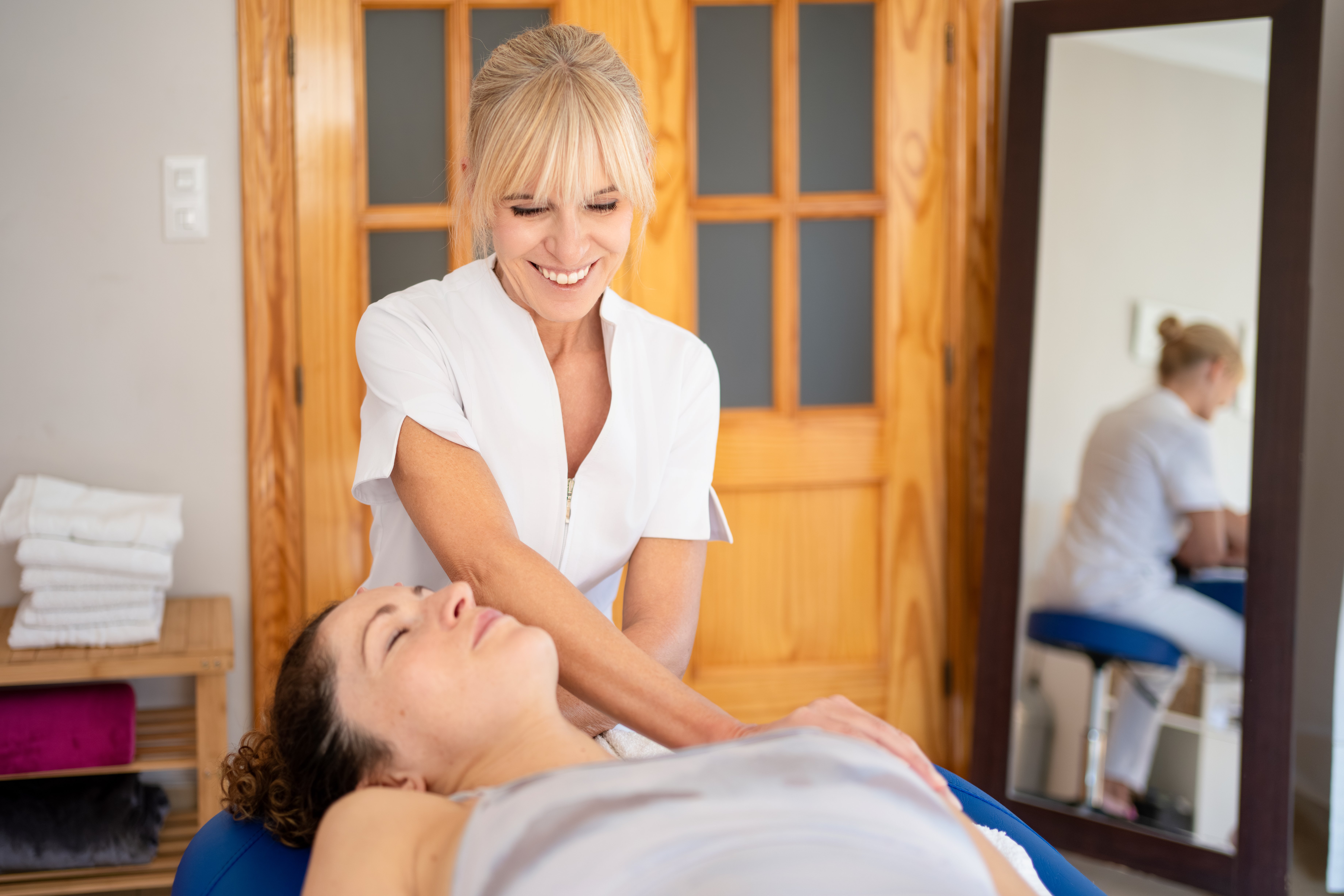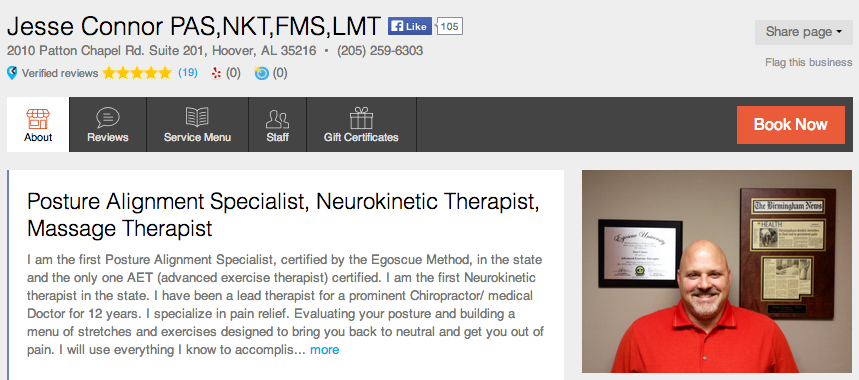Contents
Furthermore, your niche will empower you to build stronger client relationships, offer targeted services, and justify higher rates. Finding the right niche that aligns with your passions and strengths is a critical component to growth and success.
In this blog, we'll walk you through this process so you can discover yours and get it right the first time. Then, we’ll cover how to use it to build a unique and thriving practice.
What is a Niche for a Massage Business?
Before we dive into this discussion, let’s clarify what we mean by “niche.” Your niche is the type of clients you serve or the specific problem you solve.
Here are a few examples of niches for massage therapists:
- Sports recovery and injury prevention for athletes
- Pain management for office workers who struggle with back tension and neck pain
- Stress and anxiety relief for busy professionals
Please note that your niche is different from your massage modality. Modality refers to the techniques used to solve these problems, including Swedish massage, deep tissue, etc. To discover your niche, it’s important that you don’t focus too much on modality. This could create a disconnect and limit your perspective.
What are the most important steps to find the right massage niche for you?
Step 1: Identify Your Passions and Strengths
The first step is the most important part of finding your niche, identifying your passions and strengths. If you don’t pursue what you’re passionate about and good at, you’re more likely to burn out or feel like your business is stagnant.
Take the time here to reflect on what excites you most about being a massage therapist. What aspects of your practice are you passionate about, and what type of work do you feel most fulfilled in?
You might find the most joy in helping people manage stress or working with athletes recovering from injuries. Note these preferences down in writing and be sure to keep an open mind.
Once you have a few entries written down, think about why you find them fulfilling. Ask yourself what brings you satisfaction. What is it that got you into this field, to begin with? Also, in what areas do you excel naturally?
If you’re having trouble pinpointing some of these preferences, just think about a recent positive client experience. What made it positive, and how did you use your skills to solve their problem?
Write as much of this down as you can. With this kind of exercise, the more you put into it, the more you’ll get out of it. That said, in the future if you ever feel like you’re losing steam or need direction, you can revisit this exercise to refocus yourself.
Step 2: Do Your Research on Market Demand and Demographics
Now that you’ve spent some time reflecting on your passions and strengths, we can move on to aligning them with the right target market. You can research your massage target market in three steps:
- Evaluate your local area
- Conduct competitive research
- Find the service gaps
A. Evaluate Your Local Area
By evaluating your local area, you can find the best way to leverage your strengths to meet their needs. Every community is different and has its unique challenges and demands. You can use this information to help find your niche.
Research the demographic makeup of your area to find how to serve them best. If business offices surround your massage practice, you might specialize in workplace wellness and stress management. If your massage business is located near a sports-centric university, you might specialize in sports massage or injury recovery. Likewise, a younger, more active population will have different needs than an area with many elderly residents.
B. Conduct Competitive Research
To take your market research to the next level, look at what the competition is doing. You can learn a lot from seeing what kind of massage services they offer. Consider asking a few more questions about your competition.
How well are their services tailored to the local demographic? What do their package offerings look like? How about their pricing? What do their client reviews say?
C. Find the Service Gaps
More importantly, you can find gaps in their massage offerings as you conduct your competitive research. This could be a perfect opportunity for your practice and skills to fill these gaps. What are some areas you could improve upon?
How can you reach the people who aren’t quite having their needs met by the current competitive offerings? Again, write down as much information as possible, no matter how seemingly minor. Remember that, for some clients, it’s one little detail or one thing you do for them that will make their experience with you impactful and memorable.
Use this research to set yourself apart, understand the market’s needs, and create an experience that suits your audience.
Step 3: Matching Your Skills to Your Market
 By putting in the work on steps 1 and 2, you’re now ready to find the overlap. Looking over your ideal clients, the type of work you enjoy, and market research, how can you use your practice to meet the market demand? You might be able to find something ideal right away, or it may take some work to figure out how to bridge the two.
By putting in the work on steps 1 and 2, you’re now ready to find the overlap. Looking over your ideal clients, the type of work you enjoy, and market research, how can you use your practice to meet the market demand? You might be able to find something ideal right away, or it may take some work to figure out how to bridge the two.
The goal is to find the niche that moves you forward rather than getting stuck in this phase. This is especially important for our overthinkers and overanalyzers out there. Don’t worry if you can’t reach the “perfect” niche. If you can find some alignment between your preferred skills and the market, that’s a great way to move forward.
You are not carving your niche into stone. This is good news. You can learn as you go and make adjustments as necessary. You may have to change the direction of your offerings, whether it’s the services themselves or how you position them. As you gain experience, your niche can evolve. Plus, if there are gaps you want to bridge (such as a skillset that would make sense for you and your target market), you can seek certifications or professional development.
Step 4: Develop Your Unique Massage Service Offering
The next step is to create offerings tailored to your niche. If you recall from our previous post, you can add a ton of value by creating packaged services rather than limiting yourself to a session-by-session basis.
To determine the best way to structure these, think about how you can create a unique experience for your clients. By incorporating your niche, you can set up specialized packages, themed sessions, or specific pricing strategies.
If your niche is sports therapy, you might offer pre- and post-workout massage packages or create specific recovery plans for athletes recovering from injuries.
This depends on your skills, experience, and what suits your target client group best. One of the most significant benefits of finding your niche is that you can justify charging a premium for specialized services right from the start.
However, if you’re new to this niche and unsure about charging higher rates, you can offer introductory pricing to attract clients and build your reputation. You could also find ways to incentivize clients through discounted packages in exchange for long-term treatment plans.
Remember that your niche and pricing will evolve, so don’t forget to raise your rate at least every year to keep up with the rising cost of living. As always, listening to what your clients say is essential so you can use their feedback to refine your niche and offerings.
Step 5: Build Your Marketing Around Your Niche
Once you’ve found a niche that you’re happy with, it’s time to market it effectively.
Your niche sets you apart from your competition, so make sure you highlight your specialized services across all platforms. These include your website, marketing materials, social media, and anywhere else you have a presence. If your target market can see themselves in your marketing, you’re doing it right. Plus, you can leverage your expertise to create shareable, informative content that is relevant to your clients.
Let's say for instance, that you specialize in prenatal massage. You could incorporate important information in your messaging, like the benefits of massage during pregnancy, or address common concerns like swelling, stress, and muscle tension. As you get more comfortable in your niche, you can create a marketing plan to create engaging content to attract even more targeted clients regularly.
Whenever possible, take advantage of client testimonials in your marketing, especially as they relate to your niche, specifically. Sure, a testimonial that says “they’re a good massage therapist” is fine. But here’s a better example: “After my sprain sidelined me, I thought I’d miss most of the season. Thanks to my personalized recovery plan with my massage therapist, I was back on the field in just three weeks.”
Embrace Your Massage Niche and Thrive
Finding (and embracing) your massage niche might be one of the most profitable and fulfilling things you do as a massage therapist. Make sure you work on finding yours early on so that you can adapt as you go and as you grow.
With a specialization that matches your passions and strengths, you can target the right clients, get paid more (from people who will happily pay it), and cultivate a loyal client base.
Don’t wait! Reflect on your passions, align your skills, and create packages for your target clients. Feel free to take this one step at a time, but don’t put off finding your niche. As you find yours, you’ll propel your massage therapy business to new heights as you build a thriving, fulfilling practice.





